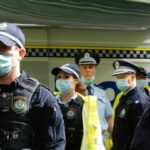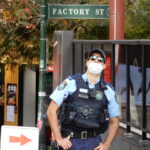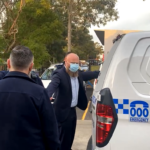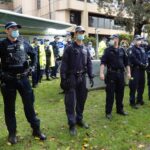“The Spectre of State Power”: USYD Professor Greg Martin on Policing the Pandemic
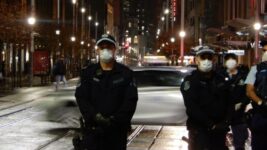
At the end of the seventh week of the Greater Sydney lockdown, the NSW government was stumped. Instead of COVID cases decreasing under the law enforcement approach to the pandemic, they were steadily rising in tandem with the ever-increasing police presence on the streets.
But the solution NSW authorities came to was simple: further increase law enforcement and punishment.
At 12.01 am on 16 August, the NSW Police Force launched Operation Stay at Home, which it described as “a significant boost to public health order enforcement efforts across the state”.
Fines were upped dramatically. Increased traffic police were deployed to conduct road stops. Certain restrictions have been tightened. And an extra 500 Australian Defence Force troops have been deployed to accompany the 300 soldiers that had been on the ground for a fortnight.
And at the last Saturday morning COVID press conference, NSW premier Gladys Berejiklian conceded that some of the enhanced restrictions around outdoor exercising aren’t evidence-based approaches, but they’re simply being applied as the NSW police commissioner asked for them.
Policing a health crisis
The decision to attempt to police the state out of a public health crisis came early on in the pandemic.
In March 2020, as the first statewide lockdown was implemented, NSW police commissioner Mick Fuller was handed full rein of the response. Public health orders were issued, restrictions were imposed, and police officers had a field day handing out penalty infringement notices.
Issues have consistently risen around the new laws as not only are they ever-changing, but they also extend a broad range of discretion to how officers apply them in field.
Involving the highly contagious Delta variant, the current wave of the COVID crisis saw NSW authorities take a rather laxed stance in imposing lockdown restrictions upon citizens, when it was initially confined to the wealthy, mainly Anglo Eastern Suburbs.
However, when the virus naturally spread to the less affluent, mainly migrant populations of the southwest, NSW police made a dramatic and highly visible decent upon them, which, at times, has appeared as if state authorities have been blaming these communities for their own failures.
Encroaching powers
Since the enhancement of police powers to enforce biosecurity measures, there have been concerns that following the threat of the virus subsiding, there will be the risk of a hangover, whereby certain elements of the COVID approach will become new policing norms.
As Professor Greg Martin has charted in his paper Protest, Policing and Law During COVID-19: On the Legality of Mass Gatherings in a Health Crisis restrictions placed on protests and public assemblies for the pandemic in early 2020, continued to apply in NSW long after the lockdown had been lifted.
Sydney Criminal Lawyers spoke to Sydney University Associate Professor of Criminology, Law and Society Greg Martin about the disparities present in the current policing approach, the militarisation of the pandemic response, and the lessons that weren’t learnt during the first wave.

Concerns over the heavy-handed policing of the pandemic are with us again. There are reports of police doorknocking at certain people’s homes on a daily basis, as well as such checks occurring after 10 pm.
Greg, what do you think about the way the pandemic is currently being policed?
It raises concerns that have been around since the second wave in Melbourne. These involve the overpolicing of certain communities and in particular, the policing of those communities that may be suspicious of police, like migrant communities and Aboriginal and Torres Strait Islander communities.
These are communities already subject to overpolicing strategies.
It raises issues around differential policing: the idea that policing is heavier in some parts of Sydney, than in others. This has been seen with people at the beach in Bondi on the weekend, whilst there are hard lockdowns in southwest Sydney regions, like Fairfield.
One of the major issues is that the enforcement messaging that’s coming across is vague. So, stay-at-home might be clear on one level, but then there are reasons to go outside.
So, you can go out for exercise. But we’re keeping the playgrounds open. Dan Andrews just said that they’re closing the playgrounds in Victoria. Yet, they remain open here. But we can go out for exercise, not leisure. So, it’s a contradictory signal.
That’s the same as the contradictory signal for authorised workers. There has never been a clear definition of what’s an essential worker, though eventually a list of authorised workers was drawn up for harder lockdown LGAs.
And you can send your kids to school if you are an authorised worker, or if you the need to send them to school. So, it creates a loophole.
There’s this vagueness around these contradictory signals. There needs to be much clearer messaging, so both police and citizens understand what’s expected.
This all goes to the issue of policing by consent, and the issue with police discretion needing to be fair and consistent. And all of those things establish a trust in the approach that’s being adopted.
If you can do that, you can bring the community along with you. But unfortunately, what appears to be happening is there’s an overplaying of the enforcement aspect.
You see it at the press conferences. You have Kerry Chant talking about the health message, but as soon as she has left you get the deputy police commissioner coming on talking about compliance and enforcement.
So, in some ways, not only is the messaging vague, but it’s also sometimes inconsistent and contradictory.
As you’ve noted, there are differences to how the pandemic is being policed across the city.
The initial response to the current Sydney outbreak was a relaxed lockdown as it began in the wealthy east of the city, but the police presence and restrictions were enhanced when it moved to the less affluent southwest.
Despite persistent questioning of the disparities in approach, they continue. What does this tell us?
The data from across Sydney, as well as in Melbourne, demonstrates that there’s an inverse relationship between fines and COVID cases.
So, 2020 police location data from Victoria and NSW indicates suburbs that are more affluent with more cases had fewer fines, while those suburbs that had higher concentrations of social housing, a higher proportion of migrants and fewer cases, had higher rates of fining.
That exposes the hidden punitiveness of fines. And these patterns show an intensification of the inequalities that already exist.
What we’ve seen with the policing during COVID demonstrates the continuation of the overpolicing of certain communities, and a lighter touch policing in others.
So, these inequalities are exposed, because the overpolicing is in the marginalised communities, with less in the more affluent.
COVID has seen a continuation of what was already happening.
Despite seven weeks of lockdown, we’re watching the number of COVID cases steadily increase.
On Saturday, NSW police announced it was enhancing its operations, which includes the implementation of random roadside checks, higher penalties and tougher restrictions.
What are your thoughts on this solution to the increasing health crisis?
There’s a contradictory set of signals being given by the authorities, politicians and police. On the one hand, we’re being told it’s a health issue, but, on the other, we’re being told it’s an enforcement issue.
What it really tells us is the situation in NSW is out of control. And the policing and law enforcement strategies are a blunt instrument, but it’s one of the only ways that the authorities can conceive of getting the numbers down.
It demonstrates a desperation on the part of the authorities. The escalation of the fines demonstrates that too. And it highlights that we can’t police our way out of a pandemic.
The data on fines shows that a large proportion remain unpaid. And if you’re increasing fines up to $5,000 for noncompliance, there are only a certain number of people who are going to be able to afford to pay that.
And we know fines are disproportionately issued to marginalised communities too, so it creates a vicious cycle.
This could create an escalating number of issues in itself, as people will start defaulting on their payments. This will mean they have to go to court. And if they’re found guilty, and they still don’t pay, they could end up in gaol.
It increases the cost of running the criminal justice system right across the board.
So, they’re storing up issues for the future, by implementing this approach. That’s why people have argued we should have a lighter touch approach to policing.
It should be more community focused, less reliance on enforcement and more focused on policing at the margins rather than through fines and punitive sanctions.
This would be a step back from a law enforcement approach. It would go towards getting the community onboard and instilling trust in the approach that’s being adopted.
A heavy-handed approach puts people’s backs up and doesn’t bring them on board.
Public health laws only commenced in March 2020, and they’re everchanging. People are asking questions as to whether police can enter a person’s house without a warrant or whether they can be arrested for not wearing a mask.
Which new laws and offences do you consider should be a concern for citizens?
The fact that people keep asking questions about the laws demonstrates there’s a messaging issue here.
What the authorities should be doing is making it very clear that you can be fined $500 for not wearing a mask, for instance, as no one is entirely abreast of the laws as they’re constantly changing.
That’s one of the key problems of policing the pandemic: the laws are constantly changing and evolving as they’re trying to fit the circumstances that are also rapidly evolving and changing.
There’s also the issue around criminalisation. What we’re seeing with COVID is a broader criminalisation, which continues criminalisation processes already present before the pandemic, as the intensification of policing is being done in communities that already had increased policing.
A fortnight ago, 300 ADF troops were deployed to the multicultural regions of Greater Sydney, which are suffering the greatest burden of the outbreak, as well as the heaviest policing. Now 500 more ADF troops are being deployed to Sydney.
What are your thoughts on the militarisation of the response?
The police in NSW and across Australia are already militarised. That, in itself, is a problem in terms of the fact that there are no guns in Australia, so why do we need heavily militarised police in the first place?
What we’re seeing with the ADF coming in is an extension of the militarisation of policing that is already present. It makes the spectre of state power more visible.
One of the problems with the militarisation of the response is that it can create fear and anxiety amongst already traumatised populations, such as refugee groups, who have come from war-torn countries.
It’s counterproductive in that sense. It doesn’t bring the community along. It creates a wedge between the police, military, the authorities, on the one hand, and the public on the other.
During the press conferences, they’ve spoken about the need for engagement with community leaders and organisations. But it’s not clear this is always happening, partly because there’s a lack of transparency around the public health data.
If we look back to 9/11 and policing of Muslim communities here, in the UK and US, the research shows that community-led policing strategies are the ones that are most effective.
And lastly, Greg you’ve written two papers on COVID policing since it was first rolled out in March last year. These have outlined issues that emerged from the policing approach taken to the initial 2020 pandemic lockdown.
What lessons would you say haven’t been learnt?
There isn’t always any clear messaging. And the messages are sometimes contradictory.
So, you’ve got health messaging, that’s immediately followed up by police enforcement messaging. And these two things are essentially contradictory.
We’re being told to provide information to contact tracers and to be truthful about movements and so forth. But then, we’re being told that if that information throws up that someone has perhaps committed an offence, then the police may intervene.
This is a great example of how the messaging and the practice around COVID policing are quite contradictory. They can be at odds with one another.
Another problem around increased policing and law enforcement is that it brings people into contact with one another. Therefore, it potentially increases viral transmission risk.
We’ve seen this in places like the US, where police have been getting sick, and then there’s not enough police on board.
At the moment, what’s happening in NSW is it’s very reliant on police numbers. But if police begin to get sick, and there’s quite a number off duty, then this strategy will no longer work due the fact there won’t be the police numbers.
So, there are a lot of unforeseen consequences of the approach that’s now being adopted.
It’s the same with the fines. If you escalate them, then there’s only a small number of people that can actually pay them. So, they’re not necessarily acting as a meaningful strategy.
Those are some of the things that have not been learnt and could be applied better.


